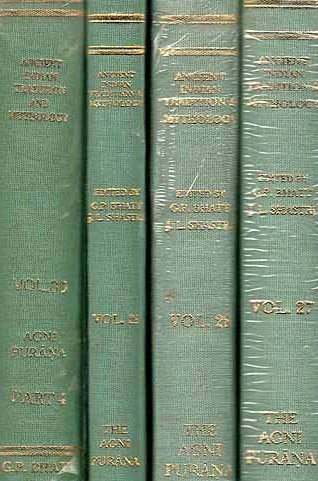The Agni Purana
by N. Gangadharan | 1954 | 360,691 words | ISBN-10: 8120803590 | ISBN-13: 9788120803596
This page describes Characteristics of images of different forms of goddesses which is chapter 52 of the English translation of the Agni Purana, one of the eighteen major puranas dealing with all topics concerning ancient Indian culture, tradition and sciences. Containing roughly 15,000 Sanskrit metrical verses, subjects contained in the Agni-Purana include cosmology, philosophy, architecture, iconography, economics, diplomacy, pilgrimage guides, ancient geography, gemology, ayurveda, etc.
Chapter 52 - Characteristics of images of different forms of goddesses
[Sanskrit text for this chapter is available]
The Lord said:
1. I shall describe (the characteristics) of the eight Yoginis (female attendants on Durgā) respectively residents of (the eight quarters) east to north-east. (The Yoginīs) Akṣobhyā, Rūkṣakarṇī, Rākṣasi, Kṛpaṇā and Akṣayā (reside in the east).
2. (The Yoginīs) Piṅgākṣī, Kṣayā, Kṣemā, Ilā, Līlā, Layā, Laktā, Balākeśī, Lālasā and Vimalā (dwell in the south-east).
3. (The Yoginīs) Hutāśā, Viśālākṣī, Huṅkārā, Vaḍavāmukhī, Mahākrūrā, Krodhanā, Bhayaṅkarī and Mahānanā (are the residents of the south).
4. (The Yoginīs) Sarvajñā, Taralā, Tārā, Ṛgvedā, Hayānanā, Sārā (Sārākhyā), Rudrasaṅgrāhī, Śambarā and Tālajaṅghikā (occupy the south (-west).
5. Raktākṣī, Suprasiddhā, Vidyujjihvā, Karaṅkiṇī, Meghanādā, Pracaṇḍogrā, Kālakarṇī and Varapradā (are the inmates of the west).
6. Candrā, Candrāvalī, Prapañcā, Pralayāntikā, Śiśuvaktrā, Piśācī, Piśitāśā and Lolupā (dwell in the north-west).
7. Dhamanī, Tāpanī, Rāgiṇī, Vikṛtānanā, Vāyuvegā, Bṛhatkukṣi, Vikṛtā and Viśvarūpikā (govern the north).
8. Yamajihvā, Jayanti, Durjayā, Jayantikā, Viḍālā, Revatī, Pūtanā and Vijayāntikā (hold sway over the north-east).
9. (These Yoginīs should be represented) as having eight arms (or) four arms, wielding weapons of their choice and yielding all benefits (on their votaries). (Lord) Bhairava may hold the arka plant (Calotropis gigantee) in the hand and have the face like the knee or elbow bearing the matted hair and the Moon.
10. Kṛttivāsas (should be represented) as holding on one side the sword, goad, axe and arrow and offering protection to the universe and a bow, trident, club with a skull at the top and noose on the other.
11. Or he shall be having five faces and be wearing the elephant’s hide and adorned by the serpents. He shall be seated on the dead body. He must be worshipped in the midst of the mother goddesses.[1]
12. One has to worship him being endowed with the letters of the alphabet upto the letter ‘ra’ and with (his mantra) having six constituents and the eight long vowel mantras.
13. (He is also to be contemplated upon) as established in the wicks of the flame in the house as endowed with golden ornaments and the nāda, bindu and indu[2] and making the body of the divine mother and the lord radiant.
14. Vīrabhadra (attendant of Śiva) (is represented) as having four faces, seated on a bull in front of the mother (goddesses). (Goddess) Gauri (consort of Śiva) (is represented) as having two arms and three eyes as endowed with a spear and mirror.
15. (Goddess) Lalitā (a form of Durgā) (should be represented) as having tour arms (holding) a spear, a small pitcher, (and another) pitcher (in the hands) and showing boonconferring hands. (She should) be seated on the lotus. (She should also) be endowed with a mirror, a small stick for applying collyrium and Skanda and Gaṇa (Gaṇeśa).
16. (Goddess) Caṇḍikā may (be represented) as having ten hands having a sword, spear, disc (and) dart in the right (hand) and the magical noose, shield, pike, axe, and bow in the left (hand). (She must) be riding a lion with the buffalo (demon) having been slain with (her) spear in front of her.
Footnotes and references:
[1]:
They are Brāhmī, Māheśvarī, Caṇḍī, Vārāhī, Vaiṣṇavī, Kaumārī, Cāmuṇḍā and Carcikā.
[2]:
These are the sound, dot and crescent, making up the Praṇava or Oṃ.
